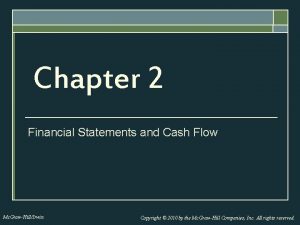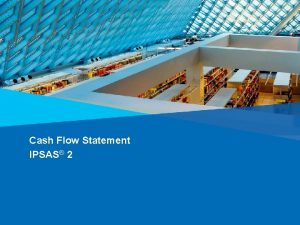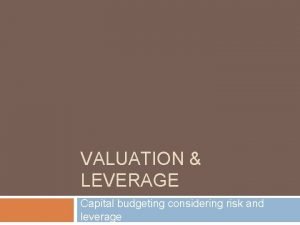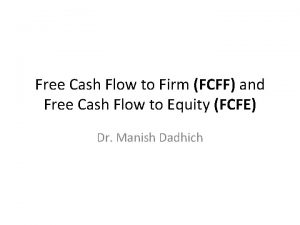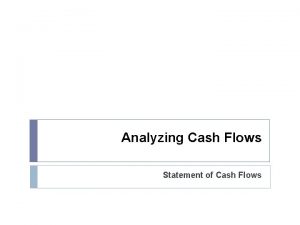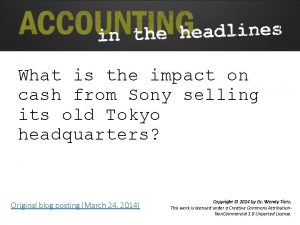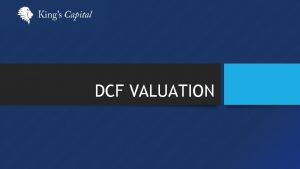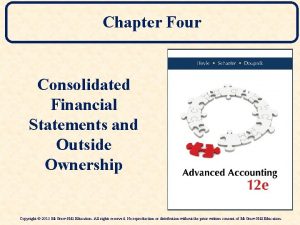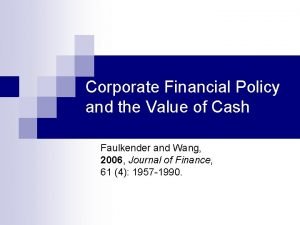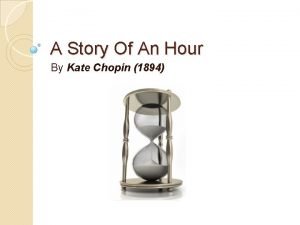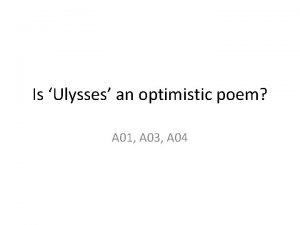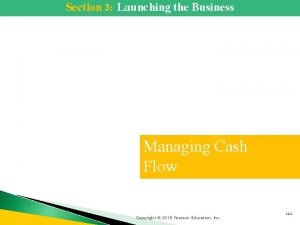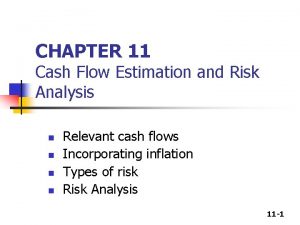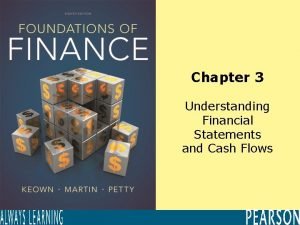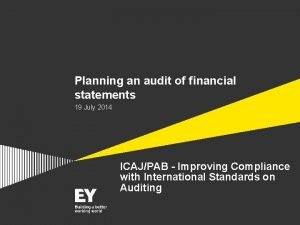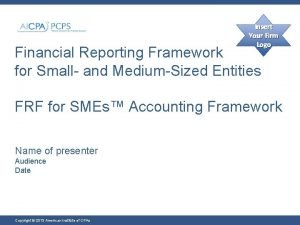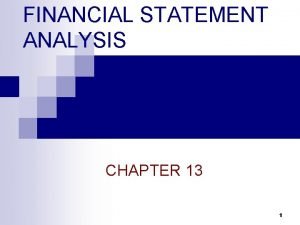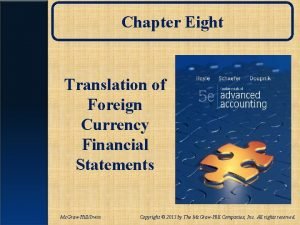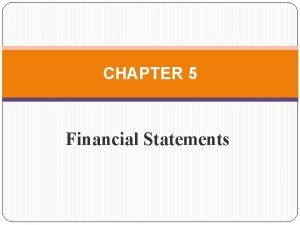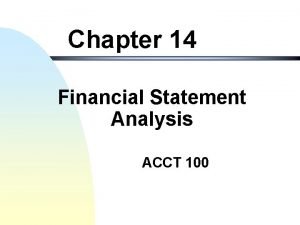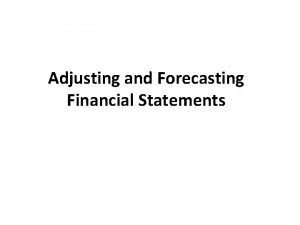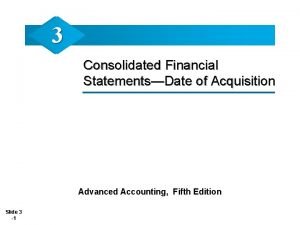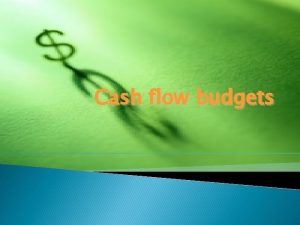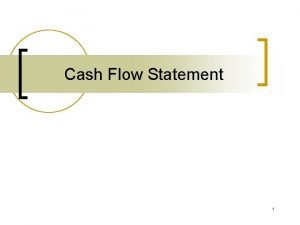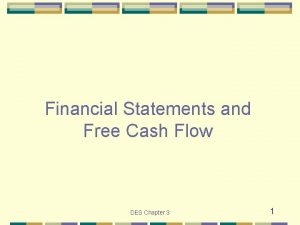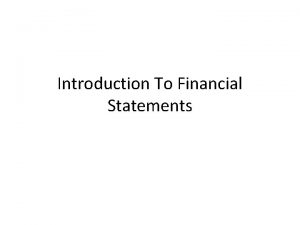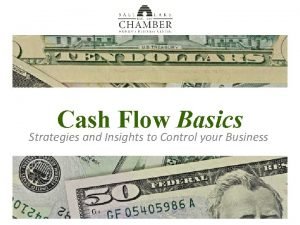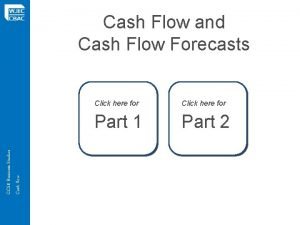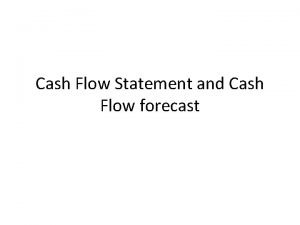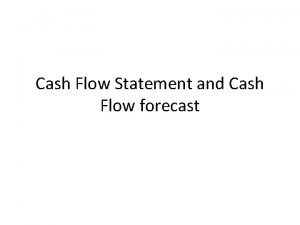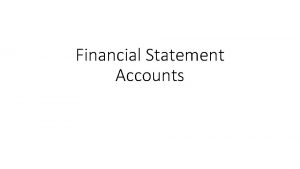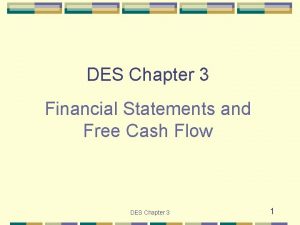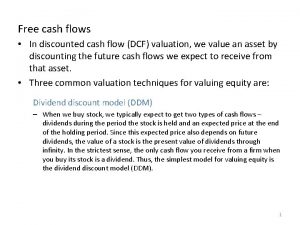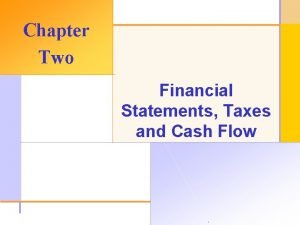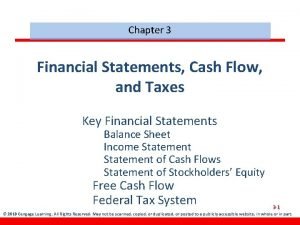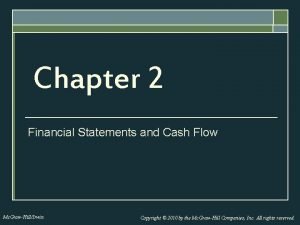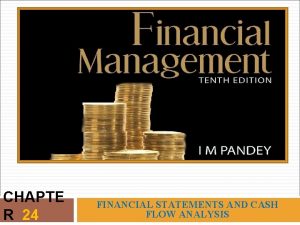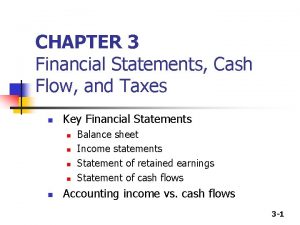Financial Statements and Free Cash Flow 1 Cash

































- Slides: 33

Financial Statements and Free Cash Flow 1

Cash is King! • Investors care about cash flow. • It is worth going to a lot of trouble to disentangle cash flow from published financial statements. 2

Annual report has 4 parts 1 • • Balance Sheet Income Statement of Cash Flows Statement of Shareholders’ Equity 1 And of course, the footnotes 3

GAAP • Statements prepared according to GAAP are reasonably consistent from firm-to-firm. • But the standard measures (earnings per share, net change in cash, net income, and return on equity) are not sufficient for valuation purposes. 4

Accruals • Part of the problem with GAAP is accruals – Accrual basis – Matching principle When does cash come in and go out, versus when are these cash flows recognized? 5

The Balance Sheet • Assets – Accounts receivable (AR)—money owed to ACME by customers who purchased on credit terms – Inventory – Long-term assets, like property, plant and equipment (PPE). – Accumulated depreciation—is subtracted from gross PPE to get net PPE. 6

Acme's Balance Sheet: Assets Cash Inventory Accounts receivable Total current assets Gross PPE Accumulated depreciation Net PPE Total assets 2014 37. 30 522. 14 932. 40 1, 491. 84 2, 619. 28 754. 48 1, 864. 80 3, 356. 64 2015 41. 40 579. 58 1, 034. 96 1, 655. 94 3, 031. 40 961. 47 2, 069. 93 3, 725. 87 2016 45. 12 631. 74 1, 128. 11 1, 804. 98 3, 443. 32 1, 187. 09 2, 256. 23 4, 061. 20 7

The balance sheet… • Liabilities and owners’ equity – Accrued expenses – Short-term debt – Long-term debt – Common stock – Retained earnings 8

Acme's Balance Sheet: Liabilities 2014 Accounts payable Accrued expenses Short-term debt Total current liabilities Long-term debt Total liabilities Common stock Retained earnings Total common equity Total liabilities and equity 372. 96 186. 48 183. 19 742. 63 1, 000. 00 1, 742. 63 500. 00 1, 114. 01 1, 614. 01 3, 356. 64 2015 413. 99 206. 99 285. 90 906. 88 1, 000. 00 1, 906. 88 600. 00 1, 218. 99 1, 818. 99 3, 725. 87 2016 451. 24 225. 62 381. 71 1, 058. 57 1, 000. 00 2, 058. 57 600. 00 1, 402. 63 2, 002. 62 4, 061. 20 9

Income statement items… • Sales – Only reflects products or services defined (according to GAAP) as sold, net of items returned. • Expenses – Cost of Goods Sold (COGS) • These are direct costs of producing products or services that were sold during the period – Sales, general and administrative expenses (SGA) • Hard to attribute these expenses to a specific item. E. g. marketing, insurance, salaries of executives. 10

Income statement items… • Expenses continued… – Depreciation • Not a cash expense. Is the recognition of money that was spent years ago on capital assets. – Operating profit = Sales – COGS – SGA – Depreciation. • Interest expense – Interest paid on debt. • Earnings before taxes – Operating profit minus interest expense • Taxes • Net income – Earnings before taxes minus taxes 11

Acme's Income Statement Sales Costs of Goods Sold Sales, General and Administrative Depreciation Operating Profit Interest expense Earnings Before Taxes Net Income 2014 3, 729. 60 2, 312. 35 745. 92 186. 48 484. 85 88. 05 396. 80 158. 72 238. 08 2015 4, 139. 86 2, 566. 71 827. 97 206. 99 538. 18 96. 49 441. 70 176. 68 265. 02 2016 4, 512. 44 2, 797. 71 902. 49 225. 62 586. 62 105. 73 480. 89 192. 36 288. 53 12

Statement of shareholder's equity • • Net Income Dividends Stock issues Stock repurchases 13

Acme's statement of shareholders' equity 2015 2016 Balance as of December 31 of previous year Net Income Dividends on Common Stock Issuance of Common Stock Repurchases 1, 614. 01 265. 02 (160. 04) 100. 00 1, 818. 99 288. 53 (104. 88) 0. 00 Balance as of December 31 1, 818. 99 2, 002. 62 14

Statement of Cash Flows • Because of accrual accounting, not everything on the income statement represents a cash flow—the statement of cash flows corrects for this. • 3 parts: – Cash flow from operating activities – Cash flow from investing activities – Cash flow from financing activities • Net cash flow 15

Cash flow from operating activities • Sources of cash flow: – Net income – Depreciation, because it was deducted from net income, but it really wasn’t a cash expense, so it is added back in. – If liabilities go up, it is like borrowing more, so it is a source of cash—so increases in accounts payable and increases in accruals are sources of cash. 16

Cash flow from operating activities • Uses of cash flow – If assets go up, that represents an expenditure (in order to pay for the asset), and so cash goes down. So if inventory increases, it required a use of cash flow to pay for it, so increases in inventory and accounts receivable are subtracted. 17

Accounts receivable • Accounts receivable deserve a bit more discussion: – An account receivable represents money for goods sold that the company has not yet received. So the company is basically lending the customer the money for the goods. It takes cash to make a loan, so if the company’s accounts receivable increase, it is a use of cash. 18

Cash flow from operating activities • Net cash from operating activities is the sum of these items. In 2016, ACME generated cash of $424. 72 million from its operating activities, despite the fact that it had net income of only $288. 53 million. The difference comes mainly from depreciation. Asset and liability changes account for the rest. 19

Acme's statement of cash flows Operating Activities Net Income Depreciation & Amortization Change in Inventory Change in Accounts Receivable Change in Accounts Payable Change in Accruals Net cash from operating activities 2015 2016 265. 02 206. 99 288. 53 225. 62 (57. 44) (102. 56) 41. 03 20. 51 373. 55 (52. 16) (93. 15) 37. 25 18. 63 424. 72 20

Investing activities • Companies use their cash to purchase fixed assets. These purchases show up here. In 2016 Acme used $411. 92 million to purchase fixed assets. This was a use of cash so it shows up as a negative number. 21

Financing activities • The money (other than that provided by operations) has to come from somewhere— this section tells where. – If short-term or long-term debt or common stock increases, then cash goes up. – If the company retires debt or repurchases common stock, then cash goes down. – Cash goes down when dividends are paid. 22

2015 2016 23

Adding them up… • The sum of cash flow from operations, investing activities, and financing activities represents the total change in cash. If this sum is positive, then the total amount of cash the company has goes up. For ACME, cash went up by $3. 72 million in 2016. 24

Net cash flow 2015 2016 Net cash from operating activities 373. 55 Net cash from investing activities -412. 12 Net cash from financing activities 42. 76 Net cash flow (net change in cash) 4. 10 424. 72 -411. 92 -9. 08 3. 72 Starting cash Ending cash 37. 20 41. 40 45. 12 25

Acme’s free cash flow • Free cash flow is cash potentially available for distribution to stockholders and creditors: – Dividends and stock repurchases – Interest and principal payments 26

Free cash flow calculation • FCF calculated as – NOPAT – investment in operating capital For 2016: NOPAT 2016 = Operating profit – taxes on o. p. =$586. 62(1 – 0. 40) = $351. 97 27

FCF calculation • Net operating working capital: – NOWC 2016 = (cash + inventory + AR) – (AP + Accrued expenses) = $1, 128. 11 • Total operating capital in 2016: – = NOWC + net long-term operating capital (which is PPE for ACME) – = $1, 128. 11 + $2, 256. 23 = $3, 384. 34 – TOC in 2015 is $3, 104. 89 28

FCF calculation • FCF = NOPAT – net investment in operating capital – = $351. 97 – ($3, 384. 34 - $3, 104. 89) – = $72. 52 million 29

Acme's Free Cash Flow Operating profit Tax on operating profit NOPAT 2014 484. 85 193. 94 290. 91 Operating current assets 1, 491. 84 Operating current liabilities 559. 44 NOWC 932. 40 Total operating capital 2, 797. 20 Investment in total net operating capital FCF 2015 538. 19 215. 28 322. 91 2016 586. 62 234. 65 351. 97 1, 655. 94 1, 804. 97 620. 98 676. 86 1, 034. 96 1, 128. 11 3, 104. 89 3, 384. 34 307. 69 279. 45 15. 22 72. 52 30

Uses of FCF • How was this $72. 52 million used? – Paid $106 million to debtholders in interest—but after-tax amount was only $64 million because it is deductible. – Paid $105 million in dividends. – For a total of $169 million, which is quite a bit more than its FCF of $73 million. It borrowed the rest, for a total new borrowing of $169 - $73 = $96 million. 31

Acme’s operating performance • ROIC = NOPATt/Capitalt-1 • ROIC 2015 = NOPAT 2015/Capital 2014 = $322. 91/$2, 797. 2 = 11. 5% • ROIC 2016 = NOPAT 2016/Capital 2015 = $351. 97/$3, 104. 89 = 11. 3% 32

Is this good or bad? • If ROIC is greater than the cost of capital (WACC) then ACME is adding value. Since WACC is 10%, ROIC shows that ACME is earning more than its investors require. 33
 2-2 journal: financial statements and cash flow management
2-2 journal: financial statements and cash flow management Cffa finance formula
Cffa finance formula Ipsas 2 summary
Ipsas 2 summary Unlevered cost of equity capital
Unlevered cost of equity capital Non operating cash
Non operating cash Fcf formula
Fcf formula Positive free cash flow
Positive free cash flow Sony free cash flow
Sony free cash flow Dcf investopedia
Dcf investopedia Financial statements and ratio analysis chapter 3
Financial statements and ratio analysis chapter 3 Unit 13 accounting and financial statements
Unit 13 accounting and financial statements Financial statements and ratio analysis chapter 3
Financial statements and ratio analysis chapter 3 Financial analysis of banks
Financial analysis of banks Partial equity method consolidation worksheet
Partial equity method consolidation worksheet What is cash in and cash out
What is cash in and cash out Corporate financial policy and the value of cash
Corporate financial policy and the value of cash Helmholtz free energy and gibbs free energy
Helmholtz free energy and gibbs free energy Summary of story of an hour
Summary of story of an hour Happy isles ulysses
Happy isles ulysses The big three of cash management include
The big three of cash management include 10-4 cash flow and budgeting answers
10-4 cash flow and budgeting answers Cash flow and cost control
Cash flow and cost control Cash flow estimation and risk analysis
Cash flow estimation and risk analysis How to calculate cash flow from profit and loss statement
How to calculate cash flow from profit and loss statement The purpose of financial statements
The purpose of financial statements Benefits of audit planning isa 300
Benefits of audit planning isa 300 Sample notes to financial statements for small entities
Sample notes to financial statements for small entities Chapter 13 financial statement analysis
Chapter 13 financial statement analysis Translation of financial statements
Translation of financial statements Objectives of financial statements
Objectives of financial statements Where is preferred dividends on financial statements
Where is preferred dividends on financial statements Forecasting income statement
Forecasting income statement Adjusting accounts for financial statements chapter 3
Adjusting accounts for financial statements chapter 3 Consolidated financial statements date of acquisition
Consolidated financial statements date of acquisition
